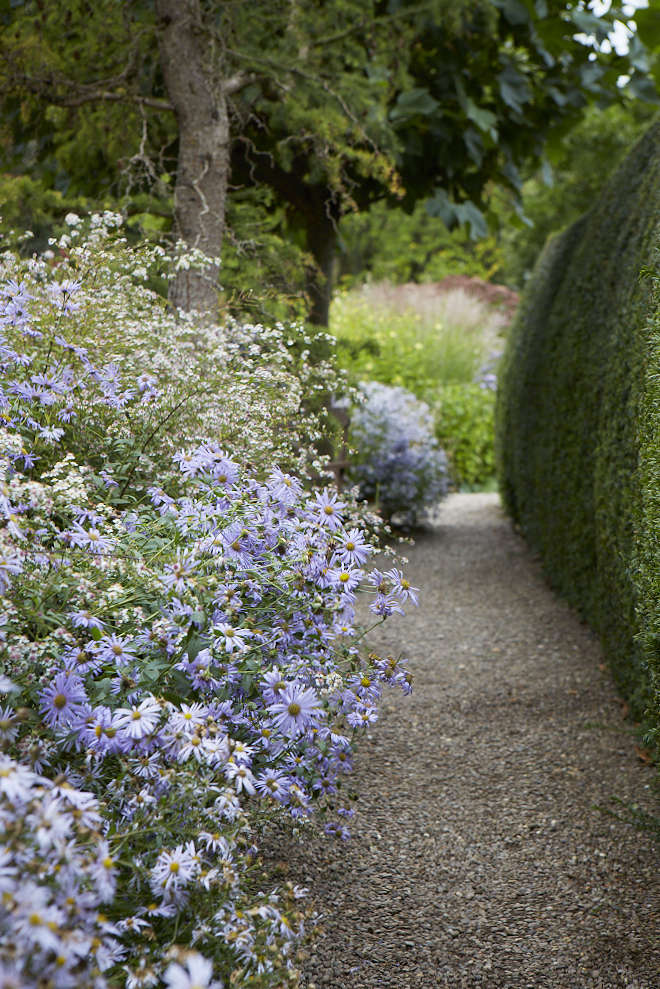Aster, Asteraceae: “Divine Daisy”
It is a mildly sad sight at the end of the summer when many plants lose their luster, with flowers fading and leaves looking a bit burned, as if they forgot their sunscreen. But late summer and early autumn is when perennial asters can save the day, and the garden.
Coming up: the most colorful season at Old Court Nurseries in England, a small family-run operation specializing since 1906 in propagating its own Michaelmas daisies (and many other varieties of asters). Photographer Britt Willoughby Dyer visited the nurseries’ Picton Garden at the height of the season:
Photography by Britt Willoughby Dyer.

Asters have a deep history in Greek mythology. According to legend, the goddess Astrea created asters with her tears. The story goes that she was so distraught at how few stars appeared in the dark sky that she started crying, and as her tears fell they turned into star-shaped asters on the ground. Aptly named for the ancient Greek and Latin word for star (because of its long, radiating petals), asters are a star of the late-summer garden.


With more than 600 species in the Aster genus, it also shares the same family as the daisy. Found wild in North America and southern Europe, asters are mainly perennials but a few are annuals and biennials. The two main groups of asters are the New England aster (Aster novae-angliae) and the New York asters (Aster novi-belgii).
While there is a galaxy of asters to choose among, a favorite is Aster frikatii ‘Monch’ for its long bloom time; it grows to a dramatic height of up to three feet and bears large lavender-blue flowers.

The downside to asters is they can be tricky when it comes to water. They tend to drop their lower leaves if not kept well-watered in the hotter months. Also, aster plants have a tendency to eventually die out in the center, making them a great candidate to rejuvenate by dividing and replanting in new clumps every two to three years.
Another issue is powdery mildew. If your garden is plagued with mildew in the fall and your asters are afflicted with this punishment, consider planting mildew-free varieties, such as the low-growing variety Aster dumosus. Another solution is to make sure asters have good air circulation around them and plenty of sun.

Cheat Sheet
- Heights vary dramatically, with varieties that range from eight inches to eight feet tall; there is an aster for almost every style of garden.
- Aster’s flat, central landing pad attracts butterflies; the nectar is a last chance to fuel up before heading south for the winter. Birds and bees also appreciate the flower, and the aster depends on these creatures to pollinate them.
- With a multitude of purposes, asters are a stunning addition to a wildflower garden, useful in a traditional border, or mingling in a rock garden.

Keep It Alive
- Grow in full sun or part sun in loamy soil (translation: well-draining but moist) and give asters regular water, especially in the summer.
- Plant most asters in the spring and amend your soil prior to planting with an organic fertilizer and then mulch with compost to keep the soil cool.
- While you can grow asters from seed, a more reliable method is to purchase a potted four-inch or one-gallon size from a nursery.

For more growing tips, see Asters: A Field Guide to Planting, Care & Design. For more late-summer ideas to perk up a garden, our Garden Design 101 guides can help.
- Looking for the perfect fall color combinations? See more about perennials at Japanese Anemones 101, Stonecrop 101, and Hellebore 101.
- Find tips about planting shrubs as a backdrop in Shrubs: A Field Guide.
N.B.: This post has been updated with new prices; it was first published October 2019.













Have a Question or Comment About This Post?
Join the conversation (1)